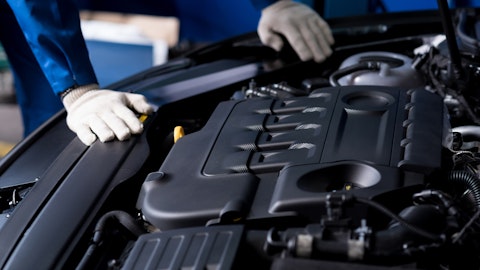Aptiv PLC (NYSE:APTV) Q2 2023 Earnings Call Transcript August 3, 2023
Aptiv PLC beats earnings expectations. Reported EPS is $1.25, expectations were $1.03.
Operator: Good day, and welcome to the Aptiv Q2 2023 Earnings Call. Today’s conference is being recorded. At this time, I would like to turn the conference over to Jane Wu, Vice President of Investor Relations and Corporate Development. Please go ahead.
Jane Wu: Thank you, Elaine. Good morning, and thank you for joining Aptiv’s Second Quarter 2023 Earnings Conference Call. The press release and related tables, along with the slide presentation, can be found on the Investor Relations portion of our website at aptiv.com. Today’s review of our financials exclude amortization, restructuring, and other special items and will address the continuing operations of Aptiv. The reconciliations between GAAP and non-GAAP measures for our second quarter financials, as well as our full year 2023 outlook are included at the back of the slide presentation and the earnings press release. During today’s call, we will be providing certain forward-looking information that reflects Aptiv’s current view of future financial performance and may be materially different for reasons that we cite in our Form 10-K and other SEC filings.

Copyright: zenstock / 123RF Stock Photo
Joining us today will be Kevin Clark, Aptiv’s Chairman and CEO; and Joe Massaro, CFO and Senior Vice President of Business Operations. Kevin will provide a strategic update on the business, and Joe will cover the financial results in more detail before we open the call to Q&A. With that, I’d like to turn the call over to Kevin Clark.
Kevin Clark: Thank you, Jane, and thanks, everyone, for joining us this morning. Beginning on Slide 3. We delivered a record quarter, demonstrating outperformance in an improving supply chain environment. Touching on a few of the highlights. Revenue increased 25% to $5.2 billion, a new record for quarterly revenue, representing 10 points of growth over underlying vehicle production, driven by strong demand across our portfolio as well as across all geographic regions. Revenues in our active safety and high-voltage electrification product line increased almost 50%, underscoring the strength of our safe, green, and connected product portfolio. EBITDA and operating income totaled a record $695 million and $530 million, respectively, reflecting solid flows on volume growth and fewer supply chain disruptions.
Partially offset by unfavorable foreign exchange rates, commodity prices, and ongoing material and labor inflation. New business bookings totaled $6.1 billion, further validating our industry-leading portfolio, the strength of our customer relationships, and our ability to execute flawlessly in a dynamic environment. Turning to Slide 4. Our first half performance substantially in line with our expectations. New business bookings totaled over $20 billion, driven by customer awards for our SBA compute and software, high-voltage electrification, user experience, and active safety solutions. Record revenue, representing 20% growth, 8 points over underlying vehicle production, in line with our long-term framework, record EBITDA and operating income as well as significant year-over-year margin expansion.
The result of strong volume growth and increased operating efficiencies, partially offset by the headwinds I mentioned on the prior slide. And we’re ahead of plan for both Wind River and Intercable Automotive solutions with both companies experiencing an uptick in commercial engagements and customer awards. Although supply chain issues persist we experienced a sequential improvement in the supply of semiconductors resulting in more stable vehicle production schedules. From a macro and industry perspective, global vehicle production has been strong, with the North American and European markets being the most resilient. Given the current industry backdrop, we’re updating our outlook for the full year. We now expect global vehicle production to increase 3% to 4%, principally driven by stronger vehicle production in North America and Europe.
Our updated outlook does not take into account any labor disruption in North America, although we do recognize that this is a real risk. Joe will provide a more granular update on our revised outlook when we review the financials. Regardless of the market backdrop, we remain laser-focused on enhancing our portfolio of safe, green, and connected solutions, executing on our commercial strategy, and optimizing our business model, which will continue to position us to benefit from the secular tailwinds. Moving to Slide 5. As I already mentioned, new business bookings during the quarter were $6.1 billion, bringing our year-to-date total to over $20 billion. Advanced Safety and User Experience bookings totaled $1.7 billion, driven by $1 billion in user experience bookings, including awards for Aptiv’s integrated cockpit controller and driver state sensing solutions.
Signal and Power Solutions bookings reached $4.4 billion, including $1.4 billion in bookings for our high-voltage electrification solutions comprised of awards across our high-voltage product portfolio, with both traditional and new battery electric vehicle manufacturers. Given the strength of our commercial pipeline, we have clear line of sight to exceed last year’s $4.2 billion in high-voltage business awards, and we remain highly confident in achieving our full-year earnings target of $32 billion. further validating the strength of our portfolio of advanced technologies and our ability to deliver exceptional value for our customers. Turning to Slide 6 to review our Advanced Safety and User Experience segment’s second quarter highlights. ASUX achieved record revenue of $1.5 billion, increasing 24 points above underlying vehicle production.
Active safety revenues increased 49%, with strength across North America, Europe, and China as the launch of our Level 2 and Level 2+ ADAS solutions continue to ramp. User Experience revenues increased 33%, driven by volume growth across key programs in both Europe and North America. And lastly, smart vehicle compute and software revenue grew 30%, reflecting Wind River’s commercial success in both the automotive and nonautomotive markets, which I’ll cover in more detail on the next slide. In terms of new business bookings, we were awarded over $400 million of active safety bookings, including program extension awards with a North American customer. As I mentioned, we’re also awarded roughly $1 billion of user experience bookings, including a significant program extension with the VW Group.
This particular award is for an integrated cockpit controller first launch on the Porsche Taycan and now being rolled out across numerous other vehicle platforms. As vehicle life cycles get shorter the ability to cost effectively extend our solutions across both luxury and mass market vehicle platforms, reinforces Aptiv’s value as a strategic partner. And as demand increases for more advanced active safety and user experience solutions, the need for more advanced compute, software development and integration capabilities as required. Our ability to provide a full suite of flexible platform solutions that are cost-effective, while providing our customers with choice, differentiates us from our competitors. And as a result, we’ve experienced an increase in the number of strategic customer engagements and are confident that additional business awards will follow later this year.
Moving to Slide 7. Wind River delivers edge-to-cloud software solutions for mission-critical applications, enabling software to find systems that require the highest levels of safety, security, and performance. The Wind River team has done a great job increasing the partner ecosystem while also winning new business, particularly in the aerospace and defense, telecom, and automotive markets, including a new program award for an A&D customer GMV to provide its edge software and with a global European truck manufacturer to provide its Linux edge software and services for their next-generation communication gateway, providing a nice entree into the commercial vehicle market. The Wind River team continues to be actively engaged with several automotive customers on enabling the software-defined vehicle of the future.
In addition, they’ve announced several new partnerships to expand their ecosystem, including with Samsung to develop a fully integrated software and hardware solution for the automotive industry. This solution will be enabled by Wind River’s Helix virtualization platform, which will allow end users to utilize a diverse set of runtime environments, including the VxWorks RTOS, Linux, and Android. Last month, the team also announced a strategic collaboration with Horizon Robotics to provide Wind River’s complete edge-to-cloud portfolio for Verizon’s automated driving compute solutions for the China market. These partnerships in automotive, along with Wind River’s continued commercial success, in its traditional markets, allow Aptiv to capitalize on the transition to a more software-defined future.
Together with Wind River, Aptiv is well positioned to provide cloud-native software solutions that help customers reduce complexity, while enabling flexibility, lower total system cost, faster speed to market, and new business models. In order to provide you with a deeper look at our software strategy, and the value that we can deliver to customers, we’ll be hosting a software teaching in September. We’re excited to tell you more about the Active Win River opportunity, and we’ll provide more details as we get closer to the date. Turning to the Signal and Power Solutions segment on Slide 8. S&PS second quarter revenues increased 21%, 6 points over vehicle production, the result of strong revenue growth in China as we lapped the COVID disruptions during the second quarter last year, a 48% increase in high-voltage revenues, reflecting strong growth across all regions and product lines, and a 32% increase in commercial vehicle revenues.
The $1.4 billion in high-voltage bookings that I mentioned previously included another strong quarter from Intercable Automotive, which I’ll touch on in more detail on the next slide. Multiple awards with the Hyundai Motor Group, including for both power distribution and battery pack electrical architecture, High Voltage Electrical Center award, a global European truck manufacturer, further increasing our penetration of the commercial vehicle market as it begins to transition to battery electric vehicle platforms. Moving to Slide 9. As I mentioned earlier, we’re on our way to exceeding last year’s record of $4.2 billion of high-voltage bookings. We continue to enhance the breadth of our high-voltage product portfolio as we introduce new offerings in power electronics and battery management systems.
And the addition of Intercable Automotive solutions expands our portfolio to include high-voltage bus bars, solid-state electrical centers, and battery cell interconnect solutions, further widening our competitive moat. We expect Intercable revenues to increase roughly 30% per year over the next several years, strengthening our position as the only full system provider of high-voltage solutions. With approximately $1 billion in bookings, year-to-date Intercable has already exceeded its 2022 full-year bookings amount. And their pipeline for 2023 new business award is now more than $2 billion, validation of the strength of their best-in-class high-voltage electrification technologies. Already a market leader with European customers, Intercable recently launched production from one of Aptiv’s facilities in North America, with customer deliveries scheduled to begin this quarter.
In addition to what Interconnect brings, we continue to experience significant commercial interest in our growing portfolio of power electronics and battery management system solutions for both battery producers and high-volume battery electric vehicle manufacturers. With our unique portfolio of high-voltage solutions and full system capabilities, we’re perfectly positioned to be the partner of choice for customers around the world as they transition to an optimized electrified vehicle architecture. Moving to Slide 10. Before I turn the call over to Joe to walk through the financials, I wanted to take a minute to recognize an important achievement by the Aptiv team. In July, Aptiv was recognized by Volkswagen with the prestigious VW Group Award one of just a handful of suppliers.
Aptiv was chosen for more than 40,000 suppliers for the top spot in the category of Global Performance Champion recognition for our product innovation and ability to keep Volkswagen connected during these challenging times. The VW and Aptiv strategies are fully aligned and our teams have been working closely over the last three years to design and develop the vehicle architecture that will enable the software-defined vehicle of the future. The Aptiv team is extremely proud of this award and looks forward to continuing to innovate and further strengthen our long-standing and strategic partnership with the VW Group. With that, I’ll turn the call over to Joe to go through the numbers in more detail.
Joe Massaro: Thanks, Kevin, and good morning, everyone. Starting on Slide 11. As Kevin highlighted, Aptiv reported another quarter of strong financial results, reflecting robust execution across both segments and continued improvement in operating performance. Revenues were up 25% to $5.2 billion or 10% above underlying vehicle production, excluding the impact of acquisitions. With outgrowth driven in part by strength in our ASUX segment, particularly in active safety as well as continued traction in our high-voltage and commercial vehicle product lines. Adjusted EBITDA and operating income were $695 million and $530 million, respectively, reflecting flow-through on increased volumes of approximately 30%, continued progress on our ongoing performance initiatives, including a $70 million improvement in supply chain disruption costs from last year, and margin headwinds of 90 basis points from FX and commodities primarily due to the stronger Mexican peso and weaker Chinese RMB.
Earnings per share in the quarter were $1.25, an increase of $1.03 from the prior year, driven by higher operating income, which more than offset the negative FX and commodity impact. Operating cash was $535 million, which was $440 million above the same period last year, primarily driven by higher earnings and reduced working capital investment during the quarter. Capital expenditures were $222 million. Looking at revenues in more detail on Slide 12. The Revenue in the second quarter was a record $5.2 billion, representing adjusted growth of 25%. Growth was broad-based across regions and segments and our recent acquisitions added $176 million of revenue in the quarter. Net price and commodities were positive, more than offsetting the FX impact on revenue.
From a regional perspective, North American revenues were up 19%, 4% above market, reflecting program timing at several customers with increased launch activity expected in the second half of the year. In Europe, revenues increased by 28%, 14% above market, supported by growth in active safety and user experience. In China, revenues grew 41% or 20% over market reflecting the strength of our underlying product portfolio, particularly in active safety and high voltage. Moving to the segments on the next slide. Advanced Safety User Experience revenues rose 39% in the quarter were 24 points over vehicle production. The outperformance was driven by strength in several product lines, including active safety where revenues were up 49%. Segment adjusted operating income was $138 million, up $168 million when compared to the same period last year, despite a 90-basis points headwind from FX, with strong flow-through on incremental volumes of approximately 30% as well as net price and operating performance that offset higher material and higher labor costs.
Signal and Power revenues were up 21%, 6 points above market. Market outperformance was driven by strength in several key product lines, including high-voltage and commercial vehicle. Segment operating income totaled $392 million, up 61% from the prior year despite an FX and commodity headwind of 90 basis points. Driven by strong flow-through on incremental volumes, offsetting the net price and commodities impact as well as improvements in operating performance to lower disruption costs, which more than offset the impact of higher labor costs in the quarter. Turning to Slide 14 and our updated 2023 macro outlook. We’ve increased our outlook for adjusted growth to 11% to 13% for the full year, a meaningful increase from our original range of 7% to 9%, and we continue to expect to outgrow the market by 9%.
The change in outlook primarily reflects increases in customer production schedules in North America and Europe, resulting in vehicle production growth of approximately 4% and 5% at the midpoint, respectively. Please note that our production outlook does not assume any significant North American labor disruptions. We expect China to be essentially flat on a year-over-year basis, in line with our prior guide. Although we continue to see strong EV penetration, particularly with our Chinese OEM customers. In addition to changes in vehicle production volumes, we have also reflected current foreign exchange and commodity rates into the updated guide. The next slide summarizes our updated 2023 outlook. We now expect revenue in the range of $19.95 billion to $20.25 billion.
EBITDA and operating income are expected to be approximately $2.8 billion and $2.1 billion at the midpoint, respectively. This reflects year-over-year operating income flow-through of 21%, in line with our historical range of 18% to 22% despite significant FX and commodity headwinds. Adjusted earnings per share of $4.75 at the midpoint, up almost 40% from prior year, driven by higher earnings, partially offset by higher tax and interest expense. Operating cash flow of approximately $2 billion, an increase of approximately $100 million over the prior guidance. Slide 16 walks prior guidance to our current outlook. Starting with revenue. Sales volume increases by $700 million, reflecting higher European and North American customer schedules. Net price, commodities, and foreign exchange contributed positively to revenue driven by the rate changes I previously discussed.
Adjusted operating income is up $125 million over prior guide as flow-through on sales growth and higher operating performance is partially offset by the negative impact of foreign exchange and the timing of copper price adjustments to our customers. Net pricing, which includes the impact of customer price downs price recoveries and material inflation remains in line with our original guidance. As previously discussed, the impact of foreign exchange movements, particularly the stronger pace for weaker RMB, have been significant this year, representing a $100 million headwind to the original guide. However, assuming rates for the balance of the year remain relatively consistent with the rates used in our updated guidance, including a stronger euro that partially offset a peso and RMB impact, we believe the majority of the negative impact has been reflected in the first half results.
In summary, we are pleased with Aptiv’s year-to-date performance, including the continued growth of our key product lines, strong bookings, and continued margin expansion. Our performance initiatives, including efforts to significantly reduce and ultimately eliminate disruption costs and to offset significant labor inflation are on track and will continue to build throughout the year. Although we remain cautious about potential negative macroeconomic conditions over the next few quarters and the potential for labor disruptions in North America, we remain confident in our ability to meaningfully outgrow vehicle production. We also believe we are well positioned to take advantage of stronger market conditions should be noted concerns not materialize.
With that, I’d like to hand the call back to Kevin for closing remarks.
Kevin Clark: Thanks, Joe. I’ll wrap up on Slide 17 before opening the line for questions. 2023 is off to a good start with record first half revenues, EBITDA and operating income, and strong margin expansion. We maintained our momentum on new business awards for optimized full-system solutions that deliver increased performance at lower cost to our customers. Our outlook for industry volumes has increased and easing supply constraints have led to fewer production disruptions and improved operating efficiencies. And we continue to focus on optimizing our cost structure to further enhance our operational resiliency. Our culture of innovation and commitment to keeping our customers connected is clearly translating into strong commercial momentum, which gives us confidence in our ability to execute our strategy, maintain our track record of performance and deliver sustainable value creation for our shareholders. Operator, let’s now open the line for questions.
See also 10 Oversold Bank Stocks To Buy and 10 Oversold Small Cap Stocks To Buy.
Q&A Session
Follow Aptiv Plc (NYSE:APTV)
Follow Aptiv Plc (NYSE:APTV)
Operator: [Operator Instructions]. We will take our first question from John Murphy from Bank of America. Please go ahead.
John Murphy : Good morning, guys. Thanks for all the information this morning. Just a simple question first on ASUX. It seems like you suddenly just kind of got into escape velocity here. And I’m just curious if that’s kind of a fair statement, particularly with these margins at 9%, they’re weigh down by some other factors. So, I mean, on a normalized basis, they’re actually reapproaching 10%. In the ramp-up of some of these growth segments, I mean, is this where we should be thinking sort of the travel rate for margins? Or is there something else going on in the quarter other than just this kind of escape velocity being reached?
Kevin Clark: Yes. John, it’s — I’ll start and Joe certainly should add to it. Clearly, the environment for semiconductors and supply chain associated with semiconductors has improved. I think as an industry with the semiconductor manufacturers, we’ve been working over the last couple of years to enhance visibility to enhance alternatives or choices. And with the slowdown in some of the consumer electronics markets, it certainly freed up incremental supply. As a result, it’s made our supply chain much more efficient, which results in lower cost from a manufacturing standpoint as well as from a freight and other standpoint, that’s reflected in our numbers to date. And then we would expect that to continue into the — obviously, into the back half of the year as we lower — Sorry, it sounds like we had a little feedback. As we have lower disruption costs, more operating efficiency, we are able to operate more efficiently and then continue into 2024 and beyond.
John Murphy : Okay. And then just one follow-up on Intercable using that sort of as a test case for some of these acquisitions that you’re making. I mean it sounds like you can’t sell this or explain it well enough at how the — or the expansion opportunity is in front of you for Intercable. I’m just curious in the current base of customers, and the $1 billion that’s been won year-to-date or booked year-to-date, are we still looking at a European centric revenue base as far as the customers and there’s just extreme opportunity in other regions and with other automakers outside of the European automakers. I’m just trying to understand where this is ultimately going to go.
Kevin Clark: Yes. I make sure I understand the question. I think today, the bulk of their revenues are related to European unbalanced programs. But as we talked about, previously. One of the reasons that we acquired Intercable is in addition to their technical capabilities and their broad portfolio a view that we could easily provide them with entrees into the North America market, which we’ve done to date, as I mentioned in our prepared comments, we’re already producing products in one of Aptiv’s existing manufacturing facilities in Mexico. Then we’ll be delivering product to a North American OEM starting this quarter, and we see significant opportunities with the other North American OEMs. And then similarly, with China, although they have manufacturing capabilities in China, just given our knowledge of the market and our experience there, we feel as though that we — we’re a great leverage point for them to sell their product into that market as well.
So, as I mentioned, their funnel for bookings opportunities is well over $2 billion. So, the opportunities are really significant with Intercable. They have a great portfolio. They have an even stronger management team. So, we’re really excited about the acquisition.
John Murphy : Great. Thank you, very much.
Operator: We will take our next question from Itay Michaeli from Citi. Please go ahead.
Itay Michaeli : Great. Thanks, and good morning everybody. Just two questions for me. Just first, I was hoping you could just walk through the how you think about the H2 versus H1 margin bridge embedded in your guidance? And then just secondly, I didn’t notice restructuring expenses kind of moved up in Q2. I think you raised your outlook there. Maybe just hopefully you could elaborate on where you’re seeing these restructuring opportunities? And how much more of the lever that could be going forward for margin expansion?




